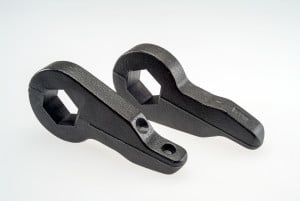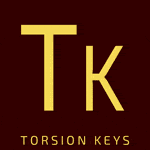What do torsion bar keys do and how do they do it?
To understand what a torsion bar key does we need to take a look at the whole torsion bar front end. First, a torsion bar is really a spring. It works just like a coil spring except it twists instead of compressing and expanding up and down.
“Turning Down” Torsion Bars
The word torsion means – to twist, and a torsion bar is a long bar lying parallel to the frame and the ground with both ends of the bar fixed. One in the frame and the other end is fixed in the lower control arm. As the lower control arm cycles up and down it twists the torsion bar and because the other end is fixed in the frame it cannot spin. Torsion bar diameter and length will determine the rate of the bar, just as the wire diameter and the number of coils determine a coil springs rate. Just like coil springs it can be very tempting to “back off” the torsion bar to lower your truck, it’s just like cutting or heating a spring, right? The biggest thing turning back the torsion bar has in common with altered springs is they are both very bad ideas! The rate of the bar does not change when you back it off but the loss of travel means a very poor ride, negative camber, premature tire wear and frankly you don’t get much drop before you run out of adjustment. The adjustment should be used to fine tune ride height after you install lowering keys or CALMAX arms.

Indexing Torsion Bars
The lowering torsion bar key works by changing the “indexing” of the bar, rotating the hexagon shaped mount. When your truck is setting still, there is a certain amount of weight being held up by the torsion bar. This weight or load is a designed amount and dictates how high your truck sets. The lowering torsion bar key by rotating the “index” (hex shaped mount) causes that designed “load” to occur at a lower ride height, while everything else stays the same.
Still you must be careful with your alignment. You can quickly run out of camber adjustment lowering this way.

